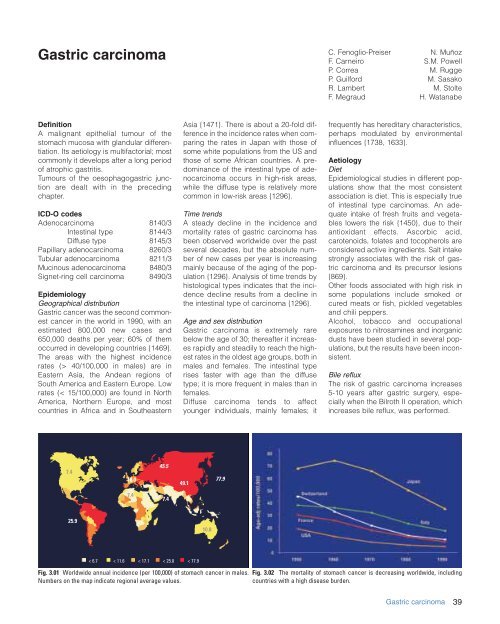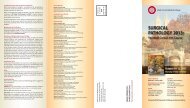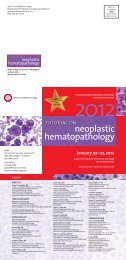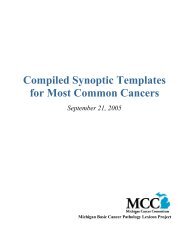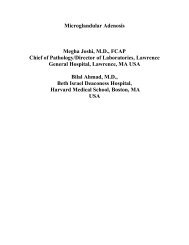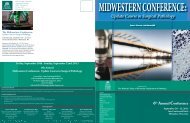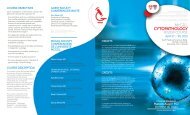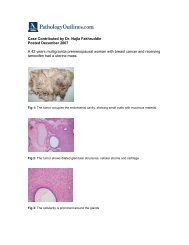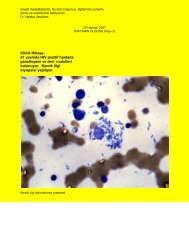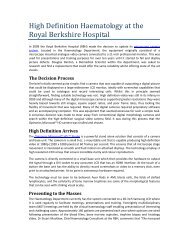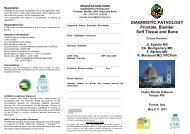CHAPTER 3 Tumours of the Stomach - Pathology Outlines
CHAPTER 3 Tumours of the Stomach - Pathology Outlines
CHAPTER 3 Tumours of the Stomach - Pathology Outlines
Create successful ePaper yourself
Turn your PDF publications into a flip-book with our unique Google optimized e-Paper software.
Gastric carcinoma<br />
C. Fenoglio-Preiser N. Muñoz<br />
F. Carneiro S.M. Powell<br />
P. Correa M. Rugge<br />
P. Guilford M. Sasako<br />
R. Lambert M. Stolte<br />
F. Megraud H. Watanabe<br />
Definition<br />
A malignant epi<strong>the</strong>lial tumour <strong>of</strong> <strong>the</strong><br />
stomach mucosa with glandular differentiation.<br />
Its aetiology is multifactorial; most<br />
commonly it develops after a long period<br />
<strong>of</strong> atrophic gastritis.<br />
<strong>Tumours</strong> <strong>of</strong> <strong>the</strong> oesophagogastric junction<br />
are dealt with in <strong>the</strong> preceding<br />
chapter.<br />
ICD-O codes<br />
Adenocarcinoma 8140/3<br />
Intestinal type 8144/3<br />
Diffuse type 8145/3<br />
Papillary adenocarcinoma 8260/3<br />
Tubular adenocarcinoma 8211/3<br />
Mucinous adenocarcinoma 8480/3<br />
Signet-ring cell carcinoma 8490/3<br />
Epidemiology<br />
Geographical distribution<br />
Gastric cancer was <strong>the</strong> second commonest<br />
cancer in <strong>the</strong> world in 1990, with an<br />
estimated 800,000 new cases and<br />
650,000 deaths per year; 60% <strong>of</strong> <strong>the</strong>m<br />
occurred in developing countries {1469}.<br />
The areas with <strong>the</strong> highest incidence<br />
rates (> 40/100,000 in males) are in<br />
Eastern Asia, <strong>the</strong> Andean regions <strong>of</strong><br />
South America and Eastern Europe. Low<br />
rates (< 15/100,000) are found in North<br />
America, Nor<strong>the</strong>rn Europe, and most<br />
countries in Africa and in Sou<strong>the</strong>astern<br />
Asia {1471}. There is about a 20-fold difference<br />
in <strong>the</strong> incidence rates when comparing<br />
<strong>the</strong> rates in Japan with those <strong>of</strong><br />
some white populations from <strong>the</strong> US and<br />
those <strong>of</strong> some African countries. A predominance<br />
<strong>of</strong> <strong>the</strong> intestinal type <strong>of</strong> adenocarcinoma<br />
occurs in high-risk areas,<br />
while <strong>the</strong> diffuse type is relatively more<br />
common in low-risk areas {1296}.<br />
Time trends<br />
A steady decline in <strong>the</strong> incidence and<br />
mortality rates <strong>of</strong> gastric carcinoma has<br />
been observed worldwide over <strong>the</strong> past<br />
several decades, but <strong>the</strong> absolute number<br />
<strong>of</strong> new cases per year is increasing<br />
mainly because <strong>of</strong> <strong>the</strong> aging <strong>of</strong> <strong>the</strong> population<br />
{1296}. Analysis <strong>of</strong> time trends by<br />
histological types indicates that <strong>the</strong> incidence<br />
decline results from a decline in<br />
<strong>the</strong> intestinal type <strong>of</strong> carcinoma {1296}.<br />
Age and sex distribution<br />
Gastric carcinoma is extremely rare<br />
below <strong>the</strong> age <strong>of</strong> 30; <strong>the</strong>reafter it increases<br />
rapidly and steadily to reach <strong>the</strong> highest<br />
rates in <strong>the</strong> oldest age groups, both in<br />
males and females. The intestinal type<br />
rises faster with age than <strong>the</strong> diffuse<br />
type; it is more frequent in males than in<br />
females.<br />
Diffuse carcinoma tends to affect<br />
younger individuals, mainly females; it<br />
frequently has hereditary characteristics,<br />
perhaps modulated by environmental<br />
influences {1738, 1633}.<br />
Aetiology<br />
Diet<br />
Epidemiological studies in different populations<br />
show that <strong>the</strong> most consistent<br />
association is diet. This is especially true<br />
<strong>of</strong> intestinal type carcinomas. An adequate<br />
intake <strong>of</strong> fresh fruits and vegetables<br />
lowers <strong>the</strong> risk {1450}, due to <strong>the</strong>ir<br />
antioxidant effects. Ascorbic acid,<br />
carotenoids, folates and tocopherols are<br />
considered active ingredients. Salt intake<br />
strongly associates with <strong>the</strong> risk <strong>of</strong> gastric<br />
carcinoma and its precursor lesions<br />
{869}.<br />
O<strong>the</strong>r foods associated with high risk in<br />
some populations include smoked or<br />
cured meats or fish, pickled vegetables<br />
and chili peppers.<br />
Alcohol, tobacco and occupational<br />
exposures to nitrosamines and inorganic<br />
dusts have been studied in several populations,<br />
but <strong>the</strong> results have been inconsistent.<br />
Bile reflux<br />
The risk <strong>of</strong> gastric carcinoma increases<br />
5-10 years after gastric surgery, especially<br />
when <strong>the</strong> Bilroth II operation, which<br />
increases bile reflux, was performed.<br />
7.4<br />
18.0<br />
45.5<br />
49.1<br />
77.9<br />
7.4<br />
7.4<br />
25.9<br />
10.8<br />
< 6.7 < 11.6 < 17.1 < 25.0 < 77.9<br />
Fig. 3.01 Worldwide annual incidence (per 100,000) <strong>of</strong> stomach cancer in males.<br />
Numbers on <strong>the</strong> map indicate regional average values.<br />
Fig. 3.02 The mortality <strong>of</strong> stomach cancer is decreasing worldwide, including<br />
countries with a high disease burden.<br />
Gastric carcinoma<br />
39


